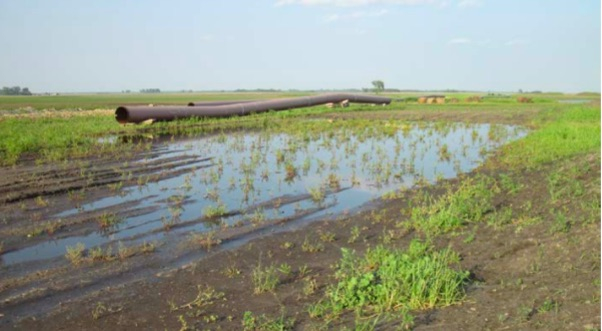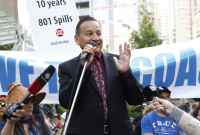Support strong Canadian climate journalism for 2025
It's described as the largest project in Calgary-based Enbridge Inc's history and although most Canadians haven't heard about it, a major expansion of the Line 3 pipeline has moved one step closer to reality.
Canada's national pipeline watchdog, the National Energy Board (NEB), gave its stamp of approval for the project on Monday. The replacement proposal would allow Enbridge to modernize, widen and increase the capacity of the existing pipeline to 760,000 barrels per day between Hardisty, Alberta and Superior, Wisconsin. This is nearly double its current capacity due to existing pressure restrictions imposed for safety reasons.
At a news conference, Robert Steedman, the NEB's chief environmental officer, said that a three-member panel of the regulator reviewed the project and determined it was unlikely to cause any adverse environmental impacts following a comprehensive environmental review.
Immediately after Steedman's news conference, Prime Minister Justin Trudeau's government announced it would be double-checking the regulator's homework, before making a final decision on whether to approve the project in the fall.
"Project reviews and consultation must be thorough to carry the public’s trust," said Natural Resources Minister Jim Carr in a statement. "Now that the NEB has completed its review, the government will take additional steps to determine if the project is in the national interest. This process includes Natural Resources Canada officials undertaking additional Indigenous consultations, and I welcome the views of communities and the public as we move toward a final decision this fall.”
The government also said it would launch a new website to invite the public to comment on the project - something that the NEB had said it did as part of its original review. The NEB's public consultation process has been criticized by many, including federal Liberals, following new rules introduced by the former Conservative government in 2012, that allowed it to prevent concerned people from testifying at hearings for proposed pipelines if they could not prove they were directly affected by the projects.
Enbridge did not respond to a request for comment. In a statement posted on its website, it said it was "pleased" with the decision and would continue to work with Indigenous and other communities to ensure they "realize" economic benefits. It also said it hoped to bring the replacement pipeline into service by 2019 depending on final government approvals in the U.S. and Canada.
The new federal review of Line 3 is based on tougher standards introduced by Carr and his cabinet colleague, Environment Minister Catherine McKenna, in January. These standards require the government to review climate change-related impacts of projects as well as ensure adequate consultations with Indigenous people and other communities that may be affected by new development.
The NEB's panel concluded that the Line 3 replacement project was in the public interest and recommended that the company must follow 89 conditions to proceed with the construction. Steedman added that the NEB was expecting Enbridge would soon submit a proposal to abandon the parts of the original aging pipeline. Line 3 is nearly 50 years old.
“We require pipelines always to be safe and operated in a safe manner," said Steedman, who spoke to reporters from the NEB's Calgary office.
If approved, Enbridge's Line 3 replacement could be welcome news for Alberta oil producers seeking access to new markets. But the project would also likely face fierce opposition from Indigenous communities and environmentalists who are worried the major pipeline project, which crosses the border in Manitoba, may cause a disaster and contribute to expansion of oilsands production - Canada's fastest growing source of climate-warming greenhouse gas emissions.
Some earlier refurbishment work by Enbridge on the Line 3 pipeline, resulted in an environmental mess, prompting complaints from local landowners and financial penalties from the NEB.
But Steedman noted that there weren't a lot of landowners who participated in the NEB's review of the replacement project, suggesting that this was likely because of Enbridge's efforts to engage with the property owners in advance.
The project would also be subject to some U.S. regulatory reviews and permits prior to final approval, but it already has a presidential permit - a missing ingredient that stalled rival TransCanada Corp's Keystone XL pipeline, the Canadian Press reported.
Enbridge has said that the Line 3 project, estimated to cost about $7.5 billion, is the largest project in its history.







Comments
Nike Freestyle Schuhe
Once you submit personalized a bankruptcy proceeding, this can be a matter of community document. You ought to be aware your own name may appear in the news and then in papers. If you do not want men and women knowing your finances, this will not be your best option for your situation.
https://www.xprofiel.nl/images/xpr2/8921-new-balance-dames-u420-blauw.j…
Financing insurance policies are a necessary acquire. Regardless of whether you may need health and life insurance or automobile insurance, you must realize what you could afford to shell out in premiums as well as the alternatives of your respective payments. Do you need to make monthly obligations or is it possible to afford bigger lump rates?
https://www.tassenmerkoutlet.nl/images/for2/7462-le-pliage-cuir.jpg
http://www.sehr-ikebap.com.tr/wp-content/book.php?vbt=137.html]Kigtropin Hgh Price In India
As important as every one of the articles in your website is, make sure to very carefully plan your site's emblem. Incorporate your keyword in to the emblem so that it will help the spiders to get your site depending on the search term. This is a quite simple issue to assist you in seo.
http://www.hosenrunter.com/wp-content/care.php?p=54]Original Viagra Preis
Gauging your revenue to reduction ratio every month may be beneficial if you wish to develop into a profitable Forex trader. Keep in mind, Forex currency trading is around long-term results, so overlooking the regular highs and lows in favour of a longer time scale provides you with a much better point of view on the situation in the marketplace.
http://www.universellekirke.dk/scripts/fime.php?catalog=Viagra-Piller-P…ænd-Og-Kvinder-116]Viagra Piller Pris
When you are having difficulties hitting the objective weight that you desire, enroll in a help group. In a support group of people, you will be all around many those who are in the exact same scenario as you may, who is able to assist motivate you till you achieve your goals. This will help a good deal mentally and physically.
http://www.marjack.com.br/form.php?idproduto=78]Levitra Kaufen Schweiz
http://www.arnoimoveis.com/access/class.php?pagina=124]hygetropin black tops 2018
Cleaning out cabinets as well as other safe-keeping places enables potential customers to imagine their particular items in that space! The greater a potential can see your home since their home by picturing them selves, their family members in addition to their items within it, the greater number of interest they will likely have in getting it. Empty half of your cabinets, compartments and cupboards like to delightful the brand new manager and you will definitely have a single significantly quicker!
http://www.eldrieny.com/images/event.php?catTitle=33-Kamagra-Bestellen-…
A great way to ease your hemorrhoids is to apply ice-cubes for your pile to aid alleviate ache. This can be a economical approach to treating soreness that only requires some dollars. Keep the daily life secure if you manage your hemorrhoids by using ice-cubes to the area affected.
http://www.palmancontrols.com/images/diculir.asp?pid=180-Viagra-Säljes-Viagra-Köpa-Viagra-Online-Billigt]Viagra Säljes
Unless you have ample resources on your verify to repay the money, a payday loan company will promote you to roll the quantity around. This only is perfect for the payday loan organization. You are going to end up trapping your self and never having the capability to repay the borrowed funds.
http://www.aegeanclipper.com/img/session.php?u=20]Cheap Cialis 20mg Australia